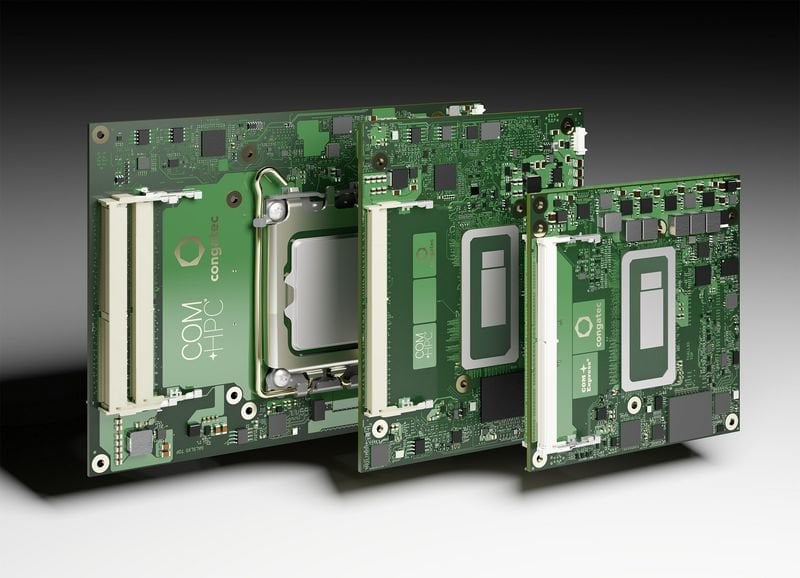electronics-journal.com
05
'22
Written on Modified on
CONGATEC LAUNCHES 10 NEW COM-HPC AND COM EXPRESS COMPUTER-ON-MODULES WITH 12TH GEN INTEL CORE PROCESSORS
Congatec – a leading vendor of embedded and edge computing technology – introduces the 12th Generation Intel Core mobile and desktop processors (formerly code named Alder Lake) on 10 new COM-HPC and COM Express Computer-on-Modules. Featuring the latest high performance cores from Intel, the new modules in COM-HPC Size A and C as well as COM Express Type 6 form factors offer major performance gains and improvements for the world of embedded and edge computing systems.

Most impressive is the fact that engineers can now leverage Intel’s innovative performance hybrid architecture. Offering of up to 14 cores/20 threads on BGA and 16 cores/24 threads on desktop variants (LGA mounted), 12th Gen Intel Core processors provide a quantum leap in multitasking and scalability levels. Next-gen IoT and edge applications benefit from up to 6 or 8 (BGA/LGA) optimized Performance-cores (P-cores) plus up to 8 low power Efficient-cores (E-cores) and DDR5 memory support to accelerate multithreaded applications and execute background tasks more efficiently.
In addition, the mobile BGA processors with, up to 96 Execution Units of the integrated Intel Iris Xe GPU have been estimated to deliver extraordinary improvements of up to 129% in graphics performance for immersive user experience and can also process parallelized workloads faster, such as artificial intelligence (AI) algorithms, as compared to the 11th Gen Intel Core processors.
Optimized for highest embedded client performance, the graphics of the LGA processor based modules delivers now up to 94 % faster performance and its image classification inference performance has nearly tripled with up to 181% higher throughput. In addition the modules offer massive bandwidth to connect discrete GPUs for maximum graphics and GPGPU based AI performance. Compared to the BGA versions, these and all other peripherals benefit from doubled lane speed as they come with ultra-fast PCIe 5.0 interface technology in addition to PCIe 4.0 off the processor. Furthermore, the desktop chipsets provide up to 8x PCIe 3.0 lanes for additional connectivity and the mobile BGA variants also offer up to 16x PCIe 4.0 lanes off the CPU and up to 8 PCIe 3.0 lanes off the chipset.
Target industrial markets for both BGA and LGA variants can be found wherever high end embedded and edge computer technology is deployed. This includes, for example, edge computers and IoT gateways incorporating multiple virtual machines for smart factories and process automation, AI based quality inspection and industrial vision, real-time collaborative robotics, and autonomous logistics vehicles for warehouses and shipping. Typical outdoor applications include autonomous vehicles and mobile machines, video security and gateway applications in transportation and smart cities, as well as 5G cloudlets and edge devices requiring AI supported packet inspection.
“Leveraging Intel’s innovative performance hybrid architecture with impressive P - core performance in combination with power efficient E - cores Intel Thread Director assigns each workload to the proper cores for optimum performance. Selected processors are also suitable for hard real-time applications with Intel TCC and TSN. In combination with full support for Real-Time Systems’ hypervisor technology, they are the ideal platform to consolidate a multitude of different workloads on one single edge platform. As this applies to low-power and high-performance scenarios alike, it enables highly sustainable designs with a small ecological footprint,” explains Christian Eder, Director Marketing at congatec.
Besides highest bandwidth and performance, the new flagship COM-HPC Client and COM Express Type 6 modules impress with dedicated AI engines supporting Windows ML, Intel Distribution of OpenVINO toolkit and Chrome Cross ML. The different AI workloads can seamlessly be delegated to the P-cores, E-cores, as well as the GPU execution units to process even the most intensive edge AI workloads. The built-in Intel Deep Learning boost technology leverages different cores via Vector Neural Network Instructions (VNNI), and the integrated graphics supports AI accelerated DP4a GPU instructions that can even be scaled to dedicated GPUs. Furthermore, Intel’s lowest power built-in AI accelerator, the Intel Gaussian & Neural Accelerator 3.0 (Intel GNA 3.0), enables dynamic noise suppression and speech recognition and can even run while the processor is in low power states for wake-up voice commands.
Combining these features with support for Real-Time Systems’ hypervisor technology as well as OS support for Real-Time Linux and Wind River VxWorks, makes these modules a truly rounded ecosystem package to facilitate and accelerate the development of edge computing applications.
www.congatec.com

